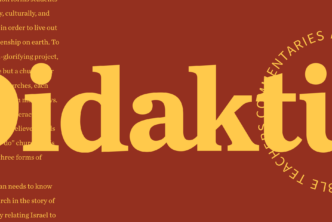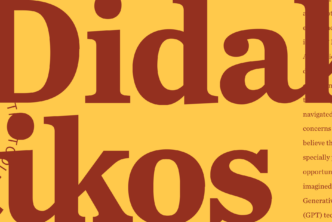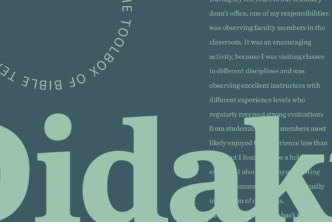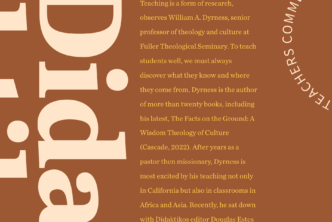How do we teach well amid the volatile social climate of our world today? How should educators from Western nations interact with scholars around the globe? And what can seminary professors do to confront racism and sexism in the classroom? These questions arose during the recent conversation between Cohick and Didaktikos editor Douglas Estes.
ESTES: With such a distinguished teaching record, what does teaching well mean to you?
COHICK: Well, first of all, I want to say I’m very flattered to be called a distinguished teacher. I don’t know I’ve ever felt that I’ve excelled in that area compared to the faculty I have participated with. I learn a lot from my peers, and maybe that is part of my philosophy going forward. For me, teaching well means being authentic in the classroom and being authentic before your students and your peers. I would say teaching well is engaging the whole person. So you’re engaging the student, the whole student—what’s going on in their lives—not to a degree that would be invasive, but just recognizing that students have a life outside the particular classroom in which you meet them. I think treating them as whole people and being a whole person in front of them is, to my mind, a key aspect of teaching well.
ESTES: Being a whole person as a professor is not always easy. We live in a time when being a professor often takes on a public role. For example, sometimes students will tweet what you say, and it can lead to miscommunication. So how does one navigate authenticity as a professor?
COHICK: You raise a great point. This is not about getting therapy done in the classroom or oversharing things or making others uncomfortable. When I say “authentic,” I guess what I mean is that you are a learner along with them. And I’m using this language of “us” and “them,” but I’d rather just say “all of us.” All of us in the classroom are moving toward a goal. And the professor is probably further along the line, at least, in terms of the quantity of material that the professor has in their head. But the students are also a very important component of the entire learning experience. And the professor is always learning. So what I mean by “authentic” is that you’re creating a learning environment where everyone is a learner. If you can be authentic in front of your students, you can respond to a question with something like, “Wow, that’s a great question. I’m not sure I have the answer right off the top of my head. Let me do some more research.”
I was speaking recently to a group of students at a sister institution. And after I presented my paper, there were a number of questions. And then one student asked a fantastic question, and so I said, “I’ve never thought of that before. Wow, I’m really not sure—here’s your dissertation topic!” Everybody kind of laughed. Later, the student indicated to me that he was kind of chided in a fun sort of way by some of his fellow students. They said things like, “Oh, you embarrassed the professor. You asked a question that she didn’t know the answer to.” And it just never occurred to me that I should feel badly about myself because a student raised a great question that I hadn’t anticipated. To me, the authenticity of the classroom is that everybody brings something to the table and everyone should be expected to contribute.
ESTES: This reminds me of my last editor’s letter where I wrote about how we, as professors, are not often thought of as being teachable. And in fact, Jerome argues that we should not be teachable—which I thought was a funny footnote of church history. But we who serve as professors come through a PhD program and engage in research. We’re always defending our views. How do we develop qualities of authenticity—such as teachable-ness as a professor?
COHICK: I think it comes down to being comfortable in your own skin. But let me fill that out a little bit. Part of it is framing the teaching enterprise. Our goal is for all of us to be more faithful disciples of Christ and to be better stewards of what God has given us. In the case of professors, God has given us certain qualities, like managing a conversation, being able to keep in our heads a variety of technical and deep ideas, and if we keep in mind that the goal is for the students to be better equipped for what God will have them do once they graduate, I think that frees us up to learn alongside them. It’s not about me in the classroom. And I think that can be very freeing, right? Because then I’m not performing, I’m not the sage on the stage. I’m not needing to perform because that’s not what the educational enterprise is about. It’s about equipping or training or exciting our students on the topics we’re teaching, to make them better able to do what God has called them to do.
ESTES: Speaking of calling, you’re the provost at Denver Seminary. What things would you look for in a candidate for professor—especially the intangible qualities?
COHICK: For me, the candidate needs to be able to engage students—and they need to do that, though, with authenticity. They need to be themselves. So I ask candidates whether they actually enjoy students. You can be teaching in liberal arts or at a research university, and your student population will be a little different. But students just know whether the professor actually cares about them or whether they are just an annoyance that the professor puts up with so they can then get on to the really important things. For the teaching enterprise, I think you have to be able to connect well—and that is not necessarily saying you need to be an extrovert or have particular characteristics or a strong personality. You can be a shy person, but if you’re authentic and you communicate that you think the student is an interesting human and you’d like to learn with them, then I would say that’s important.
ESTES: You’ve had some really great teaching opportunities, and the one I’m most interested in was your time at Nairobi Evangelical Graduate School of Theology in Kenya. How has cross-cultural teaching informed your teaching?
COHICK: A couple of things come to mind. Just at a very pedantic level, I realized how much I used cultural references and analogies in trying to communicate the first-century world and the biblical teachings in the New Testament. I’d make a reference to a movie, a very common movie that everybody would know—like a Star Wars allusion, or something along those lines. In Kenya, it didn’t resonate at all in the class. They hadn’t seen that movie, and it showed me how contextual teaching is. I would start to say, “When you go to the grocery store, and you go to choose between cereals”—and I’d think, “Wait a minute. No. They’re not going to have the kind of supermarket I’m used to, so what other kind of illustration can I use that is culturally relevant as I teach?” That was just kind of an everyday lesson that I learned.
Then the other thing I took away from that teaching experience is the incredible passion these students had for the gospel and for being on the forefront in their community in promoting gospel truth in whatever their particular context was—wherever they lived, whatever country. And I was so humbled by that. They gave up a lot, and their communities did, in order to pay for this extra education.
In fact, I actually thought, “When I then moved back to the United States, would I find teaching as exciting as it was there? Would I find students as passionate for the gospel?” And for a long time, I taught at Wheaton College, and I did find that, so I’m grateful for that experience. … So I would say those are two takeaways that kind of surprised me when I taught over in Kenya.
ESTES: I taught at a historic African-American church about two months ago, and I used a Star Wars reference with their predominantly senior congregation, and it didn’t work. It just didn’t register with the audience. It never occurred to me that, of all the cultural references I would make, that would be the one that failed to connect. So it seems like the challenge is not only that when we leave the US we’ve got this cultural baggage that has to be interpreted, but even within the US students are increasingly diverse and we have cultural challenges here. What do you think?
COHICK: Absolutely. I completely agree. And I think that’s where, if the professor is wanting to engage the students, part of that is allowing them to speak and part of that is listening. A good professor listens, right? That’s part of being authentic and being a co-learner with the class. And by the way, when I’m saying all this, I don’t mean that somehow the professor gives up leading the class. I think it’s very important for the professor to have clear outcomes and goals for the class and be able to direct the discussion. I think a good professor challenges students to think beyond what they thought they could think and to dream beyond what they thought might be possible. So I’m not saying that everyone is the same in the class in terms of what their responsibilities are. But in terms of coming as contributors and learners, that is where the commonality should be.
ESTES: In our last issue, Scott Callaham wrote about how, in the Western world today, many people in our field have PhDs but the number of academic jobs is very small, so we should look outside North America to serve. How do you feel about young men and women who get their PhDs going and serving in other countries in seminary and theological education? Is that a good thing?
COHICK: Well, the key word you used is “serving.” And if they are serving, then I think it is a great thing. If they are going over with what they believe to be this truth-in-a-box—that all they do is kind of dust off the notes from their training and just lecture to these eager students who don’t know a lot—well, then their arrogance, I think, is going to find them out. And that doesn’t help anybody. But it’s entirely different if they go over with the idea that “I want to serve the church. I have had an opportunity to get an advanced degree, and now it’s my responsibility to use that to bring others up and to help the church thrive in whatever country, wherever they are.”
I remember talking to a student as we were going somewhere in a vehicle. And when I got to where I needed to go, I was getting out of the car and I said to him, “You’re the one that’s going to write a Kenyan theology”—or I encouraged him in some way like that. “You are going to write this. This is for you to do.” And I was so amazed and humbled by his response of almost incredulity, like “What? You mean I could actually do a theology?” And I thought, “Yeah. Absolutely.” My goal as a professor is for you to do what you need to do here at the church—not just always rely on, as you were saying, things from the West, but to have there be a mutuality. We need to learn from the church around the globe. That certainly was a lesson I took away from my time in Kenya.
ESTES: Are there any avenues for faculty members to learn what’s going on around the world in theological education? What’s the best way to engage? I mean, going over there sometimes has some challenges, as you mentioned. But we’re kind of insulated here.
COHICK: Well, I think part of it is making the effort. Identify three international schools and just contact someone in your discipline. And just say to them, “I’d love to set up a conversation. I’d love to learn what are the things you face in your classroom, because I want to get to know what you’re working through in the biblical text related to your cultural situation. I think that will help me as I present the Bible to my class.” That would be one way to do it. There also are books and series that continue to come out that have, as a focus, international theology or biblical studies done by internationals. That would be another way you can do all of that without having a big travel budget on your own. But then you also could see if your institution would consider bringing over someone from a majority world seminary or undergraduate institution who would be able to have a study leave and work in your institution, and you could get to know them that way. So there are a lot of things you could do without ever leaving your hometown. It is also great to leave your hometown, but I realize a lot of times the finances make it difficult for people to do—and also life experiences. If you’ve got little kids at home, taking two weeks off and going somewhere simply isn’t practical sometimes.
ESTES: Let’s shift gears a little bit and talk about how your personal ministry has influenced your teaching. Maybe start by just giving a snapshot of what your personal ministry has been over the years.
COHICK: My ministry, I would say, is tightly tied to theological education. After we came back from Kenya, I was part of a group that wanted to raise funds for Nairobi Evangelical Graduate School of Theology. I served on that board for years and years, and I’ve stopped only because moving away from the Midwest has made that difficult to do. I’ve also been involved with the Langham Partnership for over ten years. And in both of those cases, serving on those nonprofit boards has helped me stay connected with theological education around the globe. And I would get to meet international scholars and hear what they’re working on and then read what they’ve done. That would be one of the key ministry areas I work with. I also taught a Sunday school class at church, but in terms of the connection of ministry and my job, I would say it’s service on those nonprofit boards that makes a big difference.
Before we went to Kenya, we worked for about ten years with a Cambodian community in the town where we lived close to Harrisburg, Pennsylvania. Every Sunday afternoon, we did the Sunday school for the kids. And that was was wonderful and eye-opening. We learned a new culture through the eyes of these kids as they grew up in front of us. And it was great to hear from the people of this Buddhist country what the gospel meant to them. Sometimes when you hear the gospel from a new believer—and especially a new believer who grew up in a non-Christian environment—you appreciate the gospel message in new ways.
One time I asked a young man, “So what is it about the gospel message that just touches you?” And he said, “It’s the creation story. I grew up and I never knew where I came from. And when I would ask my parents or grandparents they would say, ‘Oh, well, we came from over those hills on the other side of those hills,’ and they would point in the distance. But I never really knew where I came from. And then I read the story of God and how he created the world and how he created humanity, and I know who I am.” And even now that story just moves me when I think of it, because it helps me to see the gospel in a new way.
ESTES: Let’s talk a little about scholarship. How important is writing and publishing for faculty?
COHICK: I think writing and publishing is very important. But I hadn’t always thought that way. When I came back from Kenya, I remember hearing someone say to me, “I guess I could go over to Kenya and just teach a class of 40 people, but if I write this book, I’ll be able to impact 4,000 people.” And I remember I didn’t say anything to them. But I remember thinking, “Yeah, but will you know what to write if you haven’t talked with the broader church?” So I would say scholarship should be connected with teaching and ministry so that it is fully informed.
Now I’m going to switch gears a little bit, though, and talk about something else in terms of scholarship—and that is, if I could call it this, a theology of scholarship. When I was beginning my teaching career at Wheaton College, I felt like to write was really just to promote myself. And after I was in teaching for a little while, I realized that I needed to have a framework that allows me to see my writing as a service to the church, a service to my colleagues, a service to the students, and an obedience to what God has called me to do. I think at times I was fearful of writing something that another person would read and say, “Well, that’s just absolutely stupid.” And they may be doing this now and I just don’t know about it yet! There was a fear that I hadn’t really faced up to. It does take courage to write something down and be open to another person saying, “Boy, I don’t agree,” or “Have you thought of that?” When you write, you are putting yourself out there, and I needed that. I needed to know that this is what God was asking me to do as a matter of obedience. He has given me gifts of being able to think through problems, and I shouldn’t squander that. I should have the perseverance to write even when it’s hard. I find writing hard. I don’t write in my sleep, as I think maybe some people do! It takes a lot of discipline for me to write, but I think, OK, if that’s what God has asked me to do, then in obedience I should do that.
ESTES: Is there anything you would like all of your fellow faculty members to know? If you could have one chance to tell all theological faculty something, what would it be?
COHICK: I would say this: now more than ever, what we do matters. I think we are coming to a point where the idea of truth is questioned. And it’s important to be able to have confidence in truth. And secondly, I would say, it’s important to love our students in that perfection of love that we share in Christ. At times, teaching has devolved to advocacy only—and advocacy that puts people into groups that war against each other. Faculty have the opportunity to demonstrate a conversation to help people be able to dialogue with others, to know what they believe but accept others who might believe differently. When you think of how fractured our world is, I think now more than ever professors have the opportunity to effect change that would make for a better public square—a more loving public square. …
I think the sexism and racism we have found in our churches are issues that Christian higher education is taking up, and I would just encourage us not to lose heart in that important endeavor. It’s multifaceted, and each school and each person has different ways of thinking about how they would want to correct the racism and sexism that we have experienced. But I want to encourage people to continue in those efforts, because I think that’s an important message to the wider public—to convey that the Christian community is working on that.
ESTES: How do we as faculty—knowing that sexism and racism are sin, and knowing that the solution sometimes is complicated—how do we love our students when they engage in that behavior, even if they don’t intentionally mean to?
COHICK: If you’re seeing them through the lens of love, Christ’s love, then confronting in love is not negative. Calling someone out, embarrassing them, humiliating them, yelling, all of that is not at all helpful, right? That’s not godly. But to explain to someone why what happened is not appropriate—that, to me, is part of the job of being an educator, and that’s part of addressing the whole person. So OK, maybe you get an A on the multiple-choice exam, but you’ve not treated your sister or brother in Christ within our learning community well at all. I need to address the whole person. I need to talk with you about your failure in interpersonal skills.
ESTES: So you might say that professors should have a prophetic voice at times in the classroom.
COHICK: Yes, and the shoe can be on the other foot sometimes. Sometimes professors—inadvertently, I would assume ninety-nine percent of the time—will make a statement that is sexist or racist. They will give an example that inadvertently demeans a woman or an African-American or a Latino or another person. I think a good professor creates an environment such that a woman or a minoritized student could come up to them afterward and say, “Look, you probably didn’t mean it, but here’s how this came off to me.” And the professor can receive that and thank the student for that feedback and hopefully avoid that sort of thing again.
ESTES: Right, but love and respect have to be what goes before, or those conversations never happen.
COHICK: That’s right.
ESTES: How does a professor demonstrate love in the classroom?
COHICK: Well, I think at a bare minimum it’s about respecting your students. You believe that each person has something to contribute to class, and so you respect them in that. I would say another way to love is to encourage them or challenge them to strive for better. So those are ways of loving that try to take the students where they are, but then also try to move them and yourself—because you’re in this learning environment as well—further along in your goals of being a more educated person. And I mean “educated” in the fuller sense of the word—a contributing member to your communities.
ESTES: What is your advice to women or minoritized faculty members in the guild?
COHICK: I’d like to speak to faculty as a whole. I think as more women and more minoritized candidates become professors, it’s very important for the majority—so men and white professors—to recognize how crucial their support is to the success of their colleagues. It’s important for male professors to promote their female colleagues in front of the students. And they need to, in some cases, almost reassure some of their students that it’s OK to have a woman teach the Bible. If the school has made that arrangement, then her male colleagues may feel like, “Well, why am I needing to be so active in this?” But it really often requires that, because students won’t necessarily accept the female professor. So I would say that active encouragement of female and minoritized faculty is really important for the faculty as a whole.
This also plays out with student evaluations. Tests and studies in the social sciences have shown that there are different expectations that students bring into a class if it’s run by a woman or it’s run by a man. I remember hearing about a study where there were two faculty members, a man and a woman, who did an online class.1 And the experiment was that, in one case, the students thought they were taking a class taught by a man when it was really the woman who was teaching, and then that scenario was reversed. The students evaluated their classes higher if they thought a man was teaching it and lower if they thought a woman was teaching it. So let’s say the man’s name is Bob. When he was known as Susan to the students, they evaluated him lower than when he was known as Bob. And it was the same also for the woman. She scored higher than the man did if he was identified as Susan, and she scored higher if she was identified as Bob. So it’s important for faculty as a whole to recognize some of the hurdles that the women and the minoritized faculty in their midst face, and then to take an active role in trying to mitigate that as much as possible.
ESTES: You were talking about a theology of scholarship, and earlier you said that authenticity is important for faculty. And then you talked about how, if somebody from North America goes to other parts of the world, they should serve and not come in with a truth-in-a-box. So I see a common bond here toward authentically knowing who you are. Is that a fair interpretation?
COHICK: I think that would be a good thread to perceive throughout this. I thought of the verse from Ephesians 4:15—speaking the truth in love—and if I’m thinking about theological education, there has to be that component of truth. And, of course, truth for the believer is personal, it’s not simply data. It has a relational component to it. And then love, which is putting others before yourself. Theological education has to involve both. There has to be content, and that’s where scholarship gets so important. It can’t just be about sharing your feelings, as though that counts for academic rigor. There has to be scholarship there, but it’s in the framework of putting others before yourself.

From Nairobi to Brisbane to Denver, Lynn Cohick has taken part in theological education across cultural lines. She is the author of a number of commentaries on Philippians and Ephesians and a coauthor of the recent book Christian Women in the Patristic World (Baker Academic, 2017). Cohick currently serves as provost at Denver Seminary and as president of the Institute for Biblical Research.
This interview was first published in Didaktikos: Journal of Theological Education. Subscribe today:

- See Lillian MacNell, Adam Driscoll, and Andrea N. Hunt, “What’s in a Name: Exposing Gender Bias in Student Ratings of Teaching,” Innovative Higher Education 40 (2015): 291–303; and for further discussion, Kaitlin Mulhere, “Students Praise Male Professors,” Inside Higher Ed, 10 December 2014; and Colleen Flaherty, “Bias Against Female Instructors,” Inside Higher Ed, 11 January 2016.





